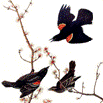Wildlife Damage Management, Internet Center for
Document Type
Article
Date of this Version
September 1970
Abstract
The annual testicular cycle of many avian species which reside in temperate zones can be divided into two stages: the recrudescent stage and the regressive stage. The recrudescent stage is characterized by an increase in testis size which reflects the transition from an aspermatogenic condition to a spermatogenic condition. At the end of the breeding season, the birds enter the regressive stage. During this period a marked decrease in testis weight and volume indicates the return to an aspermatogenic condition. This stage is maintained until the next spring when presumably the increasing photoperiod induces gonadal recrudescence. If the birds are exposed to spring-like photoperiods immediately after the beginning of the regressive stage, the testes fail to respond. This post-spermatogenic phenomenon is termed photoperiodic refractoriness. The present investigation examines the photoperiodic regulation of the annual testicular cycle of adult Eastern Red-winged Blackbirds (Agelaius phoeniceus phoeni-ceus). The testicular cycle of captive birds maintained indoors on a natural photo-period was compared with the recorded gonadal size of wild birds collected in Michigan between 41.5° and 43.5° latitude. In addition, studies were undertaken to determine the presence, duration, and character of the refractory period. This description of the annual testicular cycle provides background information for studies which may attempt to produce or extend the infertile period as a means of controlling the population size of this species.


